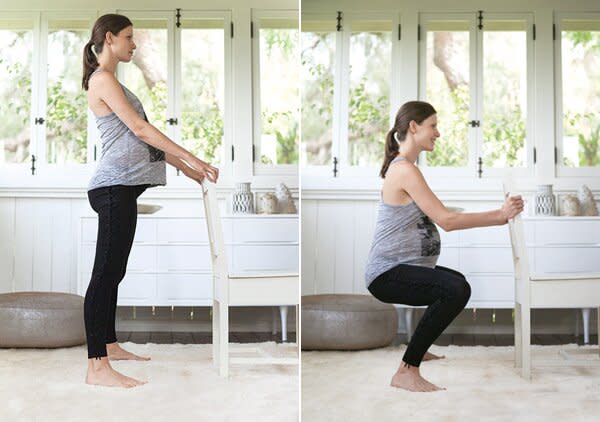The Best Pelvic Floor Exercises During Pregnancy

Fit Pregnancy
When you're pregnant, the payoffs for developing strong abdominal and pelvic floor muscles are plentiful. "These muscles are a pregnant person's best friend," says Julie Tupler, R.N., creator of Diastasis Rehab in New York City and author of Maternal Fitness: Preparing for a Healthy Pregnancy, an Easier Labor, and a Quick Recovery. "If your abs are weak, you won't be able to push effectively," she explains. Having a strong pelvic floor can also assist during labor, as well as help prevent urinary incontinence later. But how can you strengthen your pelvic floor? What exercises are best to do during pregnancy?
From elevators to squats, here's everything you need to know about pelvic floor exercise.
Important Muscles While Pregnant
The transversus abdominis, or transverse, is the innermost abdominal muscle. It encircles your trunk like a corset and involuntarily contracts when you sneeze. The action of this muscle is forward and backward, which compresses the abdominal cavity, and it can help you push during labor.
The main muscle of the pelvic floor, the PC (short for pubococcygeus), lies in a figure eight around the openings of the urethra, vagina and rectum. Kegel exercises strengthen the pelvic floor muscles, helping to prevent the urinary incontinence that's common after childbirth. To do Kegels, squeeze the muscles around the vagina as if you are stopping the flow of urine; hold for 10 seconds, breathing normally, then slowly release. Do 20 reps five times a day.
Pelvic Floor Exercises for Pregnancy
These pregnancy pelvic floor exercises and abdominal exercises, designed by former Fit Pregnancy fitness editor Teri Hanson and based on the Tupler Technique, will also teach you how to work the muscles separately. The goal: During the pushing phase of labor, you ideally draw in the deep transversus abdominis, or transverse, muscle and relax the pelvic floor to let the baby out. Do these exercises in the order shown up to three times a day, performing 10 repetitions of each move and progressing to 20 reps when you feel strong enough.
1. Belly Breathing
How To: Sit with your legs crossed and lower back supported, hands on your belly. Keeping your back and shoulders still, slowly inhale through your nose as you expand your belly. As you exhale through your mouth, draw in your abdominals, bringing your navel toward your spine.
Benefits: Strengthens abdominals
2. Belly Dancing on All Fours
How To: Get down on your hands and knees, wrists under shoulders and knees hip-width apart. Keeping your back flat, draw your abdominals up and in, bringing your navel toward your spine; hold, breathing normally. Tilt your pelvis under, bringing your pubic bone toward your navel.
Hold and count to five. When you complete the final rep, stand up by stepping one foot forward and pushing off your thigh with both hands.
Benefits: Strengthens abdominals, back and upper body
3. Elevators
How To: Sit with your lower back supported, one hand on your upper belly and the other near your navel.
Imagine your transverse is a horizontal elevator with six "floors." Inhale, then exhale, drawing your abs toward your spine to the fifth floor. Hold and count out loud to 30. Do five squeezes from the fifth to the sixth floor.
Benefits: Strengthens abs, especially the transverse
4. Squat Combo
How To: Holding a fixed object, such as a post or a sturdy chair, stand with your feet farther than hip-width apart.
Lower your body into a deep squat, keeping your weight over your heels. (If your heels do not touch the floor, place a towel under them.) Do a Kegel then draw your abs in as you exhale. Repeat combo five times.
Benefits: Strengthens abs, legs, and pelvic floor
